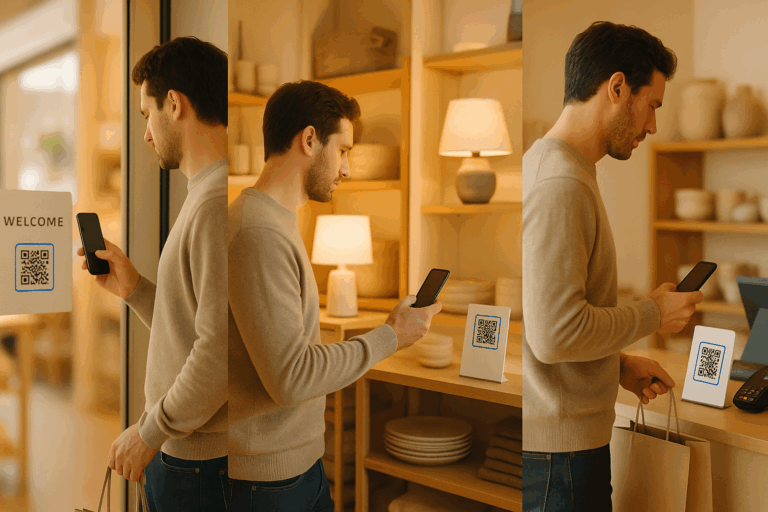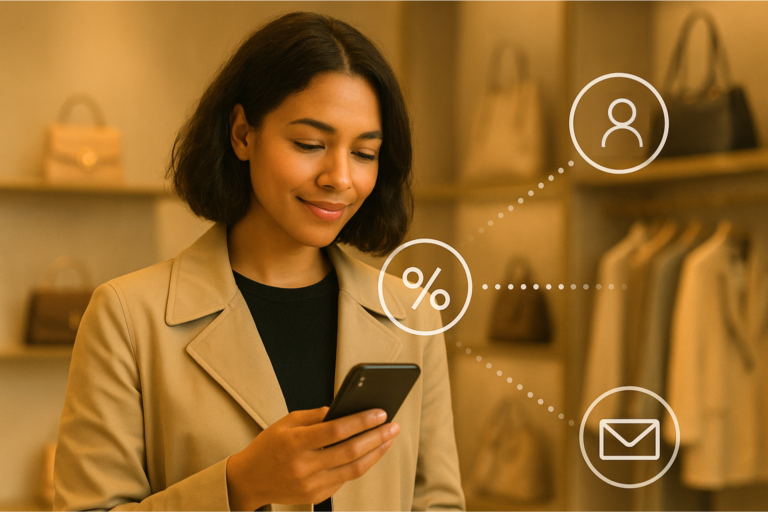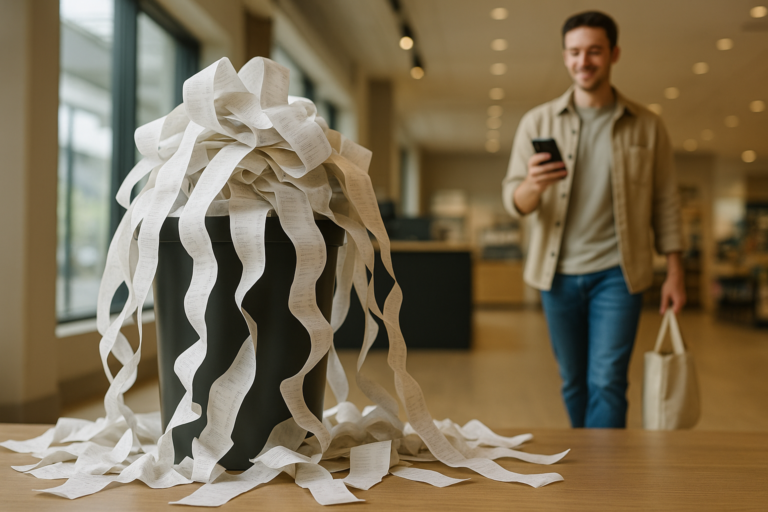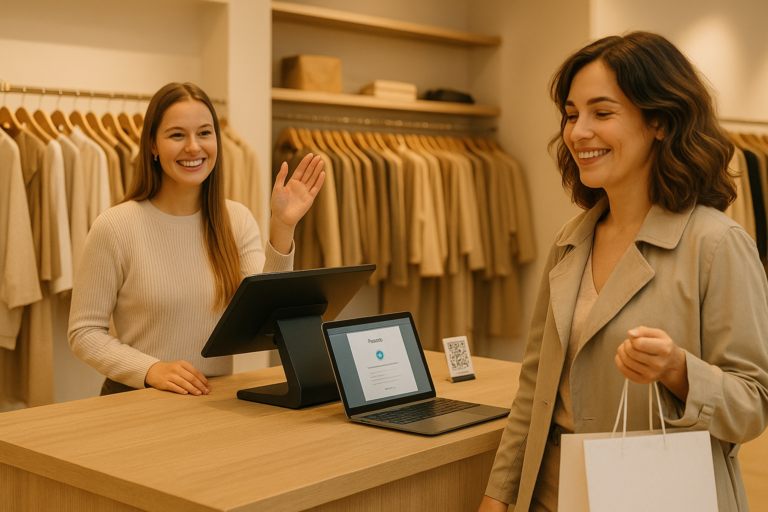TL;DR
If your store still feels like a transaction, not an experience, you’re leaking loyalty. In 2025, the best customer retention strategies aren’t louder – they’re smarter and create reasons to come back. This blog breaks down five things the best brands are doing differently to make stores feel personal, emotional, seamless, and worth showing up for. Miss even one, and you’re giving customers a reason to stay home.
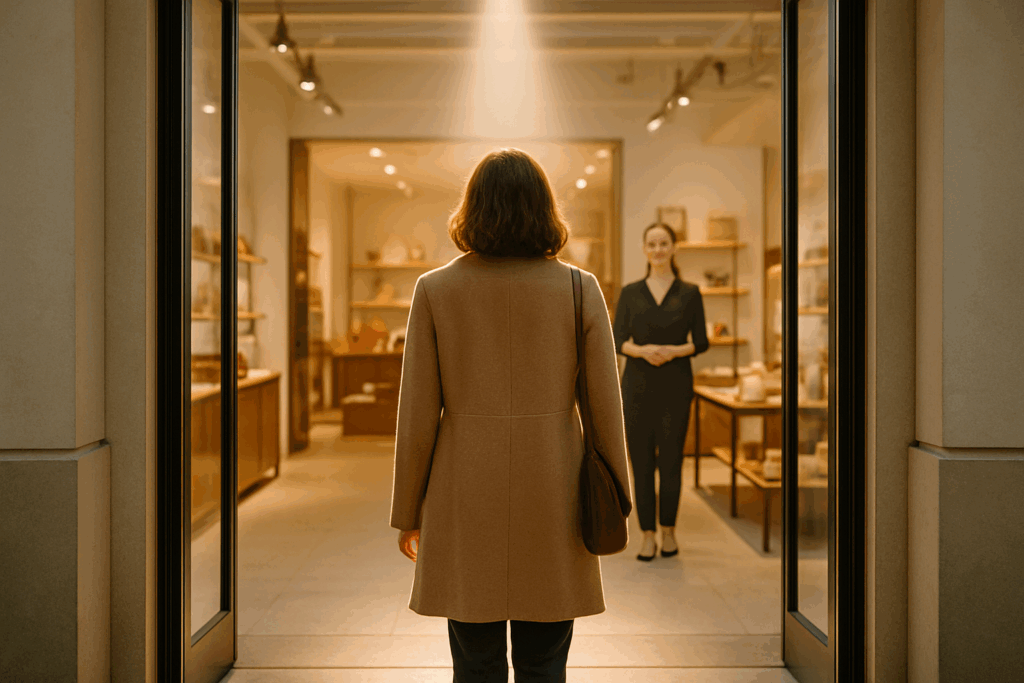
Here’s what’s fascinating about retail right now: while everyone predicted that one-click ordering, same-day delivery, and AI shopping assistants would empty our stores, the opposite happened. 76% of total retail sales still happen in-store. Even Gen Z, the generation that grew up with smartphones glued to their palms, actually prefers real-life shopping for discovery and experience.
But you already know this. What you’re really asking is: why do some stores become magnetic while others feel forgettable?
The answer isn’t in your product mix or pricing strategy. It’s understanding that online is fast, but physical is emotional. When customers choose to leave their homes and walk into your space, they’re buying into an experience that exists nowhere else.
At the risk of sounding cheesy (here goes), you have a magical weapon.
Stores aren’t dying. They’re being redefined. The retailers building the future understand that customer retention strategies aren’t about loyalty points or email campaigns. They’re about creating spaces so compelling that visiting becomes a ritual customers actively crave.
The advantage of stores lies in experience, community, and connection – three things that can’t be digitized. The most successful experiential retail concepts aren’t competing with e-commerce. They’re competing with entertainment, with social media, with everything else vying for people’s time and attention.
So how do you build that kind of magnetic in-store customer experience? You’re about to find out.
Retail as Entertainment
People don’t go to stores to just shop anymore. They go to feel something.
Coach proved this with their Tabby Tour, where a simple ice cream truck and personality quiz drove something remarkable. Customers waited 60-75 minutes just to get in and then stayed longer than typical retail dwell time. Why? Because Coach transformed product discovery into an experience worth the wait. Giovanni Zaccariello, Coach’s SVP of global visual experience, put it perfectly: they wanted customers to have “a memorable experience and create a strong emotional connection.”
Watch The Retail Spotlight Podcast Episode with Giovanni Zaccariello for more such insights!
Vans London installed a 200-square-meter skateable travertine ramp directly into their Oxford Street flagship. Not a display about skating – actual skating! Customers can book lessons, watch demos, or just experience the space where retail and recreation merge completely.
Meanwhile, Glossier SoHo turned their flagship into content creation central with subway-themed selfie installations and mosaic murals.
The extreme end is Omega Mart by Meow Wolf in Las Vegas – a 52,000 sq ft “supermarket” where shopping becomes adventure gaming. Customers discover hidden portals, interact with surreal products, and find secret bars. It’s retail disguised as entertainment, or entertainment disguised as retail. You decide.
The insight that changes everything: When shopping becomes entertainment, customers stop calculating time spent and start calculating memories made.
Retail as Community & Culture Hub
Time to sell belonging in your stores! When AMI Paris opened “La Cabane AMI” this summer at Galeries Lafayette, complete with chef Julien Sebbag’s crêperie and panoramic views, they were creating a reason to linger, to meet, to make memories.
JW Anderson’s Soho flagship embodies this shift perfectly. Beyond the clothes, you’ll find Charles Rennie Mackintosh furniture, Akiko Hirai ceramics, and coffee-flavoured tea from Postcard Teas. The space hosts workshops, readings, and neighborhood events – transforming shopping into cultural participation.
Meanwhile, Coach Play stores are seeing GenZ customers spend 8-12 times longer than typical visits, drawn by coffee bars, customization stations, and weekly events featuring DJs and local food vendors.
Even Superdrug’s new Beauty Playground concept recognizes this trend, installing ring lights for content creation alongside try-me tables. Fun!
When customers see your space as part of their social ecosystem, retention follows naturally.
Retail as Sensory Experience
Smart retailers are designing environments that hit every sense simultaneously to create “rich encoding” – deeper memory formation that drives loyalty.
Take Rituals’ House of Rituals in Amsterdam. Walk in and you’re hit with carefully crafted fragrances. But the clever bit is upstairs: their Mind Spa offers “brain massage” treatments with synchronized sound, scent, and light. Downstairs, restaurant Rouhi serves Arabic-Asian fusion designed to awaken your taste buds. It’s retail therapy meets actual therapy.
Meanwhile, biophilic design – living walls, natural materials, spa-inspired layouts – is proving its commercial worth. Studies show stores with natural elements see 25% higher foot traffic and 33% more customer interaction. Even Rare Beauty’s pop-ups leverage this, creating immersive setups that blend wellness with beauty discovery, creating a breather from the chaos outside.
Here’s the thing: when senses align around a brand story, shopping stops being transactional. Customers remember how the space made them feel, not just what they bought. That’s stickier than any loyalty program.
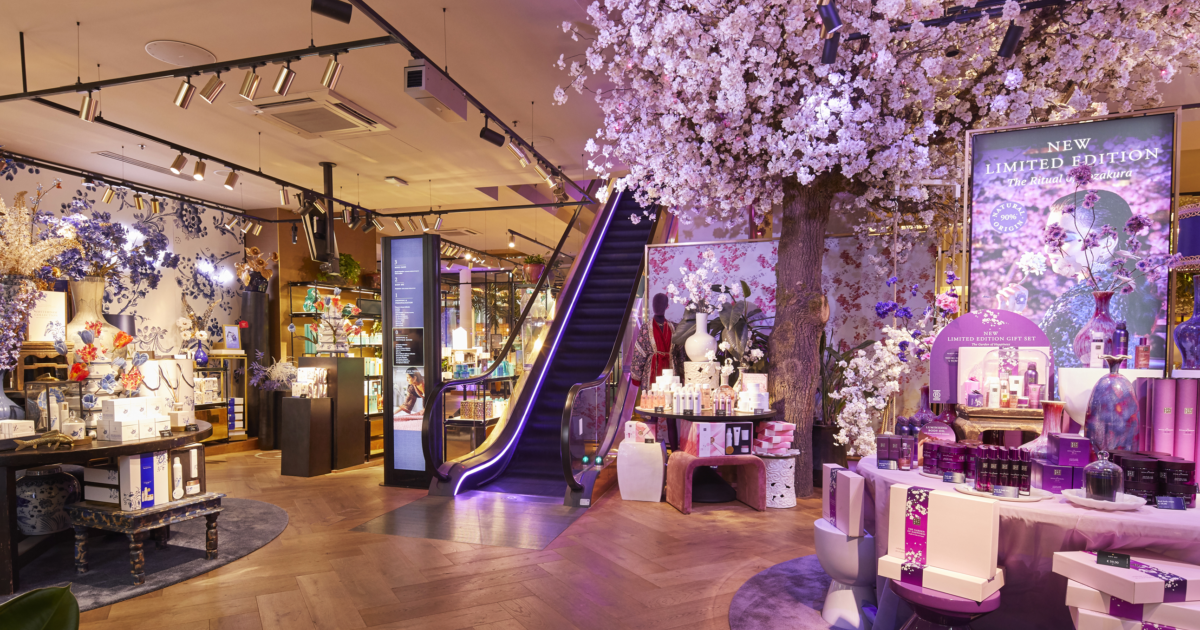
Retail as Connected Playground
Technology only works when it serves the experience, not the other way around. Let’s NOT cram screens into every corner.
Coach’s SoHo AR mirrors make handbags float with butterfly wings – silly? Maybe. Effective? Window engagement jumped 94% in week one. That’s the point: they turned shopping into play.
Lowe’s went full sci-fi with NVIDIA digital twins that give associates “X-ray vision” to see what’s inside boxes on high shelves. Samsung’s Mumbai store lets you test everything from phones to smart fridges in 1,600 square feet of pure hands-on heaven.
Brands like Gusti Leather, Khaadi, and Puma are connecting these dots too – using smart touchpoints from entry to checkout that capture customer information and create seamless handoffs between browsing, buying, and what happens after.
Read the Gusti Leder Case Study: How a Leading Retail Brand Uses refive to Connect with In-Store Customers
When tech becomes invisible infrastructure that serves a purpose rather than flashy features, it’s a win.
Five Principles That Turn Stores Into Destinations
What we can learn from all this and how to bring it to life.
1. Design for Emotion, Not Just Transaction
Yes, optimize for efficiency but also for feeling. Humans make decisions with their hearts first, then reverse-engineer the logic later. The stores that understand this create experiences that customers can’t shake.
Think about why you remember certain spaces long after leaving them. It’s sometimes the functional stuff – the wide aisles or clear signage. But It’s also the way light filtered through windows. The scent of fresh bread from the bakery that stopped you mid-browse. These aren’t happy accidents. The best retailers engineer emotions as deliberately as they plan inventory.
And it doesn’t stop at the door. Brands use smart touchpoints, as simple as a digital receipt, which invites customers to leave feedback while the moment is still fresh, unlock a surprise reward, link their purchase to loyalty, or offer product tips they didn’t know they needed.
More than proof-of-purchase, it’s proof of relationship.
2. Make It Feel Personal, Even at Scale
Here’s what separates brands that scale successfully from those that become generic: they capture and use customer insights to get better at being human, not more efficient at being robotic.
Every interaction tells you something about what someone values, prefers, or needs. Are you collecting these insights? More importantly, what are you doing with those insights?
You can use it to make each moment feel like it was designed for the individual standing in front of you. And without relying on staff to remember names, because let’s be real.
Personalization can happen invisibly. Timing, context, and behavior all quietly inform what’s shown, suggested, or rewarded.
3. Treat the Store Like a Storytelling Channel
To quote Imagine Dragons, make me a believer!
Your store isn’t just a point of sale – it’s a stage. And every inch of it is communicating something, whether you’re being intentional about it or not.
Physical retail is a 3D expression of who brands are and why they matter. The vibe, the flow, the music, the lighting, the textures – they all play a role.
It’s why a Dyson store feels like a lab, not a showroom. Why Coach Play stores look like candy-colored street sets and invite you to “come play.”
Treat every shelf, screen, and staff touchpoint as part of a larger arc. Use in-store moments like waiting in the checkout line to build context, ask for feedback, showcase your loyalty program, and expand the brand universe.
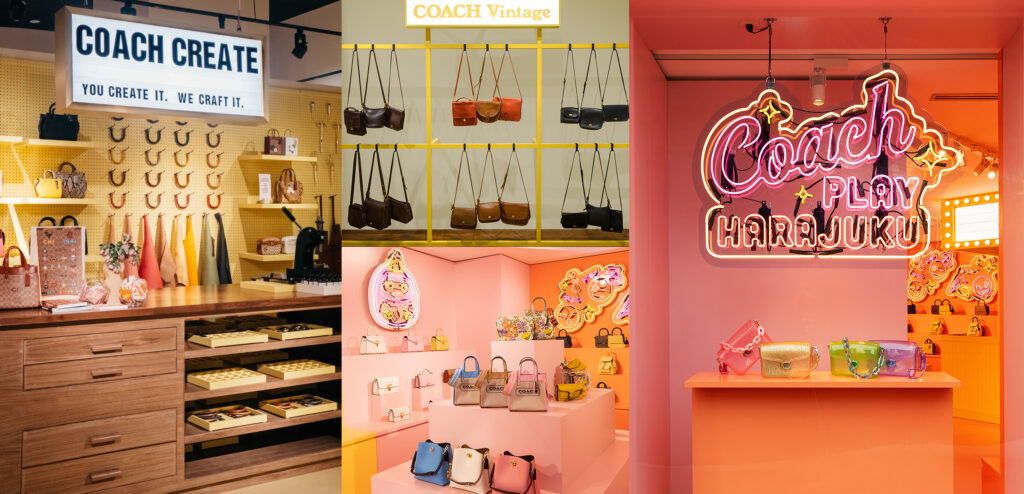
4. Remove Friction. Add Delight.
Let’s eliminate annoyances with little moments of “oh, that was easy.”
Nobody wants to hunt down a store associate just to check a product detail or wait in line to ask if there’s another size in the back. No one enjoys rattling off their email (again) at the register or fumbling through paper receipts when something needs returning.
The retailers who win in 2025 are removing these snags – not by adding more staff or signage, but by designing for flow.
Smart stores today help customers help themselves: from finding the right aisle to checking stock or discovering complementary items with a tap. Even the checkout line isn’t a dead zone anymore – it can be an opportunity to learn, redeem, or just finish faster.
That’s the feeling people come back for.
5. Let Customers Choose the Journey
It’s 2025 and we can’t force a fixed path. Customer-obsessed brands design multiple, equally good ones. They recognize that “great service” looks different to different people. Some love chatting with staff and asking for recommendations. Others prefer to scan, browse, and buy without interruption.
What matters is that both types, and everyone in between, feel equally seen.
That means giving customers control. Letting them decide how they get product info. How they check out. How they receive a receipt, whether that’s email, WhatsApp, or just a quick download on their own phone. Letting them pick the rhythm and the touchpoints that work for them.
The store isn’t the journey. It’s the starting point. And the more flexible you are in letting people move through it, the more likely they are to move toward you again.
Too Much to Tackle At Once? Start Small (and Smart)
You don’t need to overhaul your store or install futuristic light tunnels to create better customer journeys.
Start where the friction is. Start with the moments they’re already having, right when they walk in, mid-aisle, at the till. From giving them better ways to opt in, to showing the right info when curiosity strikes, to capturing the kind of feedback they’ll actually give – the journey improves fast.
Your team will thank you. Your customers will feel it.
Let’s make your store the one people actually get off the couch for in 2025.
- What customer retention strategies actually work in physical retail today?Emotional design, personalized follow-ups, and low-friction journeys. If your store nails even one, you’re already ahead. If not - there are smart ways to fix it without overhauling everything.
- How do you measure if your in-store experience is actually working?Track engagement beyond sales: dwell time, repeat visits, voluntary contact sharing, increased opt-ins for your loyalty program. Smart retailers use digital receipts and QR touchpoints to capture real-time sentiment and create follow-up loops.
- Do digital receipts actually improve customer retention?Yes, when done right. Digital receipts create ongoing touchpoints for personalized offers, loyalty enrollment, and feedback collection. They turn one-time transactions into relationship-building opportunities while providing valuable customer data for future engagement.
- What's stopping most retailers from creating better in-store experiences?Budget concerns and integration complexity. The solution is to start with enhancing obvious touchpoints like product shelves and checkout. Smart retailers use digital solutions that layer onto current systems rather than replacing everything. Small changes in these moments create big relationship shifts.



